- Home
- Max Brooks
Closure, Limited and Other Zombie Stories
Closure, Limited and Other Zombie Stories Read online
CLOSURE, LIMITED
Also by Max Brooks
The Zombie Survival Guide
World War Z
Recorded Attacks
First published in 2012 by
Duckworth Overlook
90-93 Cowcross Street
London EC1M 6BF
Tel: 020 7490 7300
Fax: 020 7490 0080
[email protected]
www.ducknet.co.uk
© 2012 by Max Brooks
All rights reserved. No part of this publication may be reproduced, stored in a retrieval system, or transmitted, in any form or by any means, electronic, mechanical, photocopying, recording or otherwise, without the prior permission of the publisher.
The right of Max Brooks to be identified as the Author of the Work has been asserted by him in accordance with the Copyright, Designs and Patents Act 1988.
A catalogue record for this book is available from the British Library
eISBNs
Mobipocket: 978-0-7156-4389-1
ePub: 978-0-7156-4388-4
Library PDF: 978-0-7156-4387-7
Contents
Introduction
Closure, Limited: A Story of World War Z
Steve and Fred
The Extinction Parade
Great Wall: A Story from the Zombie War
To Michelle Kholos Brooks, who makes everything possible.
Introduction
The zombies came for me. I certainly wasn’t looking for them. It was sometime in 1985. I was somewhere between 12 and 13 years old. My parents had just got something called ‘cable TV’ and according to the schoolyard rumour mill, this new invention sometimes showed real women willing to take their shirts off for no particular reason! Every time my parents went out to dinner, I made a beeline for their bedroom. I sat in front of that screen with the patience of a Buddhist monk. I waited, I hoped, I prayed, and then one night, it happened. There she was, a real live woman, completely naked! She was walking through some tropical village as the natives danced around her. As my adolescent brain tried to comprehend what my eyes were harvesting, all I could think of was ‘My life has changed forever’. I had no idea how right I was.
They came out of the darkness, shambling, moaning suddenly... the party was over.
My memories are hazy from that moment on. Mostly they consist of nightmare flashes of screaming people being grabbed, their flesh torn and eaten. I remember a small animal (a cat?) leaping from the corpse of an old woman. I remember an ashen cadaver with dried blood hanging from the lips. I remember a national leader pleading for help while the other UN Delegates argue fecklessly about solutions. Most of all, I remember THEM. Mindless, slow, completely inhuman. They reminded me of a movie I’d seen recently about a giant shark that one character had called ‘an eating machine’. They reminded me of a movie about a killer cyborg that ‘doesn’t feel pity or remorse or fear and absolutely will not stop, ever!’ They reminded me of a very real plague that was now ripping through my parents’ world and killing their friends in droves. They were the worst terror I could have imagined. They were zombies.
The movie I’d seen that night was called Night of the Zombies, and I’m 99.9% sure that the filmmakers mixed actual documentary cannibal footage into their tour de force. Whether that’s true or not, each frame was burned into my adolescent brain. For years I remained haunted by these inhuman and, I thought, invincible abominations. The humans in the movie seemed powerless before their carnivorous onslaught. Wouldn’t the same be true of me? That was the fate I had resigned myself to until him!
His name is George A. Romero and his movie is called Night of the Living Dead. I must have been 17 or 18 when I saw it, now in my own room with my own cable TV and, I’m sure, no less obsessed with shirtless women than I was at the dawn of puberty. I thought I’d put my zombie nightmares behind me, and now here they were again! The flesh eaters were back, and no less ravenous than their Italian cousins. Just like before, I was terrified by the carnage unfolding before me, and just like last time, I could not look away.
But then it dawned on me, this movie had something completely absent from that exploitative nihilistic Euro blood orgy. This movie had HOPE! Suddenly there were rules, concrete boundaries that delineated the strengths and weaknesses of the attackers. They weren’t as smart as us, or as strong, or as fast. Most importantly, they could be stopped! One bullet to the brain, that’s all it took! And suddenly I got it! The terror wasn’t the zombies, it was our own inability to deal with them! That wouldn’t be me! I’d make the right decisions. I’d do my homework. I wouldn’t surrender to stupidity or fear. When they came for me, I would do whatever it took to survive!
A lifetime later, as the world braced for the all but inevitable Y2K apocalypse, I found myself reading an ever-growing stack of disaster preparedness manuals and thinking ‘What about zombies?’ Surely someone must have written a book on how to survive an attack by the living dead. Surely some obsessive compulsive nerd with far too much time on his hands must have asked himself ‘what if’ enough times to do something about it. As luck would have it, that obsessive compulsive nerd turned out to be me.
I never expected The Zombie Survival Guide to be published. I wrote it to read it. The living dead continue to fascinate (and terrify) me, and the older I get the greater my obsession grows. Zombies are a global phenomenon, the perfect lens for examining societal collapse. They are SARS, they are AIDS. They are the hurricane that drowned an entire city, or the ‘master race’ that burned an entire continent. They are an existential threat, a slate wiper, and have an ability to expose our own suicidal weaknesses; I’ll never lose my fear of them.
Closure, Limited:
A Story of World War Z
BERUFJORDUR, ICELAND
Thomas Kiersted looks exactly like his prewar picture. His frame may have thinned considerably, and his salt-and-pepper hair may have lost all its pepper, but his eyes show no trace of ‘survivors’ stare.’ He waves to me from the deck of The African Queen. The three-hundred-foot former sailing yacht is still a magnificent vessel, despite her patched sails and naval grey paintwork. This former plaything of the Saudi royal family now flies the flag of the European Union and is the mobile headquarters of ‘Closure Limited.’
Welcome aboard! Doctor Kiersted holds out a hand as the supply launch pulls alongside. Quite a party, eh? He refers to the collection of warships and troop transports anchored in the fjord. Good thing for us this is only a recce expedition. It’s getting harder and harder to secure our subjects. South and East Asia are secure, Africa’s drying up. Russia used to be our best exporter, unofficially, of course, but now... They really mean it, closing their borders. No more ‘flexible negotiations,’ not even on the individual level. What’s this world coming to when you can’t bribe a Russian?
He chuckles as we head below to B deck. A loud commotion roars down the passageway from a lit hatchway.
No, it’s not that. Kiersted gestures over his shoulder. Cricket season, Sri Lanka versus the West Indies. We get the BBC live feed directly from Trinidad. No, our subjects are all kept below in specially modified cabins. Not cheap, but nothing we do here is.
We descend to C deck, past crew cabins and various equipment lockers. Officially our funding comes from the EU Ministry of Health. They provide the ship, the crew, a military liaison to help collect subjects, or, if no troops are available, enough money to pay for private contractors like ‘the Impisi’, you know, the ‘Hyenas.’ They don’t come cheap either.
None of our public funding comes from America. I watched the debates your Congress had on C-SPAN. I cringed when that one senator tried to suppo
rt it openly. He is now, what, working as an underling in your Department of National Graves Registration?
The irony is most of our money comes from America, from private individuals or charities. Your name removed for legal reasons set up the fund that’s given dozens of your countrymen a chance to use our services. We need every dollar, or Cuban peso, I should say, the only money that really means anything now.
It’s difficult and dangerous to collect subjects, very dangerous, but that part of the process is relatively inexpensive. The preparation—that is where the real money goes. It’s not enough to just find a subject with the right height, build, gender, and reasonably close facial features. Once we have them—he shakes his head—then the real work begins.
Hair has to be cleaned, cut, possibly dyed. Most of the time facial features have to be reconstructed or else actually sculpted from scratch. We have some of the best specialists in Europe and America. Most of them work for standard wages, or even ‘pro bono,’ but some know exactly how much their talent is worth and charge for every second of their time. Talented bastards.
We come to E deck, now closed off by an armoured hatch guarded by two large armed men. Kiersted speaks to them in Danish. They nod, then look at me. My apologies, he says, I don’t make the rules. I show my ID, both U.S. and UN, a signed copy of my legal disclaimer, and my letter of consent, stamped with the seal of the European Union’s Minister of Mental Health. The guards examine them closely, even using prewar ultraviolet lights, then nod to me and open the door. Kiersted and I pass into an artificially lit passageway. The air is still, odourless, and extremely dry. I hear the thrum of either several small or one extremely large and powerful dehumidifier. The hatches on either side of us are solid steel, opened only by electronic key, and warning in several languages for unauthorized personnel to stay out. Kiersted lowers his voice slightly. This is where it happens. Preparation. I am sorry we can’t enter; a safety issue for the workers, you understand.
We continue down the passageway. Kiersted gestures to the doors without touching them. Face and hair are only part of the preparation. ‘Wardrobe personalization’—that is a challenge. The process simply won’t work if the subjects are, say, wearing the wrong clothes or missing some kind of personal item. Here, at least, we can thank globalization. The same T-shirt, say, made in China, could be found in Europe, America, anywhere. The same for electronic items, or jewellery; we have a jeweller on contract for specialty items, but you’d be surprised how many times we’ve found clones for so-called ‘one-of-a-kind’ pieces. We also have a specialist for children’s toys, you see, not to make them, but to modify them. Children specialize their toys like no one else. A certain teddy bear is missing an eye, or an action figure has one black boot and one brown. Our specialist, she has a warehouse in Lund. I’ve even seen it, a massive old airplane hangar, with nothing but specialty piles of exact toy pieces: dolls’ hairbrushes and Action Man guns—hundreds of piles, thousands. Reminds me of when I visited Auschwitz as a student—the hills of eyeglasses and little children’s shoes. I don’t know how she does it, Ingvilde. She is driven.
I remember once we needed a ‘special penny.’ The client was specific. He used to be some kind of ‘entertainment agent’ in Hollywood, managed name withheld for legal reasons and a lot of other dead stars. In his letter he said that he once took his son to a place called ‘Travel Town,’ some sort of train museum in Los Angeles. He said it was the only time he’d ever spent a full afternoon with his son. Travel Town had one of those machines where you put a penny in, and cranking the handle presses it into a special medallion. The client had said that on the day they fled, his son had refused to leave it behind. He even made his father punch a hole through it so he could wear it around his neck on a shoelace. Half the client’s letter was devoted to describing that special penny. Not just the design, but the colour, ageing, thickness, even the spot on it where he’d punched the hole. I knew we’d never find anything close to that. So did Ingvilde, but you know what she did? She made another one, completely identical. She found the company’s records online and gave a copy of the design to a local machinist. She aged it like a master chemist—the right combination of salt, oxygen, and artificial sunlight. Most importantly, she made sure that the penny was made before the 1980s, before the American government removed most of the copper. You see, when you squeeze it flat and the inside metal shows... Sorry ‘too much information’ as you Americans say. I only mention it to illustrate the kind of dedication we have to our work here. Ingvilde, incidentally, works on a subsistence salary. She’s like me—‘rich person’s guilt.’
We reach F deck, the deepest level aboard The African Queen. Although artificially lit like the deck above, these bulbs are as bright as the prewar sun. We try to simulate sunlight, Kiersted explains, and each compartment is specially equipped with sounds and smells tailored to the client. Most of the time it’s peaceful—the smell of pine and the chirp of birds—but it really depends on the individual. We once had a man from mainland China, a test case, to see if it was worth their government setting up their own operation. He was from Chongqing, and he needed the sounds of traffic and the smells of industrial pollution. Our team actually had to mix up an audio file of specific Chinese cars and trucks, as well as this noxious brew of coal and sulphur and lead-filled gasoline.
It succeeded. Just like the special penny. It had to. Otherwise why the hell would we do it? Not just spend all the time and money, but the sanity of our workers. Why are we constantly reliving something the whole bleeding world is trying to forget? Because it works. Because we help people, we give them exactly what the company name says. We have a seventy-four per cent success rate. Most of our clients are able to rebuild some semblance of a life, to move beyond their tragedy, obtain some semblance of ‘closure.’ That’s the only reason you’d find someone like me here. This is the best place to work through ‘rich person’s guilt.’
We come to the last compartment. Kiersted reaches for his key, then turns to face me. You know, before the war, ‘rich’ used to mean material possessions—money, things. My parents didn’t have either, even in a socialist country like Denmark. One of my friends was rich, always paid for everything, even though I never asked him to. He always felt guilty about his wealth, even admitted it to me once, about how ‘unfair’ it was that he had so much. ‘Unfair.’ For the first time since our meeting, his smile fades. I didn’t lose one family member. I mean it. We all survived. I could figure out what was coming, as Americans say, ‘put two and two together.’ I knew enough to sell my house, buy the tools to survive, and get my family to Svalbard six months before the panic. My wife, our son, our two daughters, my brother, and his whole family—they’re all still alive—with three grandchildren and five great nieces and nephews. My friend who had ‘so much,’ I treated him last month. They call it ‘rich person’s guilt,’ because life is the new wealth. Maybe they should call it ‘rich person’s shame,’ because, for some reason, people like us almost never talk about it. Not even to each other. One time I met with Ingvilde at her shop. She had a picture on her desk, facing away from me when I entered. I didn’t knock, so I surprised her a little bit. She snapped that frame down on her desk before she even knew it was me. Instinct. Guilt. Shame. I didn’t ask who was in the picture.
We stop at the final compartment. A clipboard rests on the bulkhead next to the hatch, a clipboard holding another legal disclaimer. Kiersted looks at it, then me, uncomfortably.
I apologize. I know you’ve already signed one, but because you’re not an EU citizen, regulations demand that you reread and re-sign another form. The rereading part is a pain in the arse, and if it were up to me, I’d allow you to just sign it, but His eyes flick to the surveillance camera on the overhead.
I pretend to read. Kiersted sighs.
I know that a lot of people don’t agree with what we do here. They think it’s immoral, or at least wasteful. I understand. For a lot of them, not knowing is a gift. It protec
ts them and drives them. They use it to push their lives forward, rebuild both physically and mentally, because they want to be ready for the day when that missing person suddenly walks through the door. For them, limbo is hope, and sometimes, closure is the death of hope.
But what about the other type of survivors, the ones who’re paralyzed by limbo? These are the ones who search endlessly through ruins and mass graves and endless, endless lists. These are the survivors who’ve chosen truth over hope but can’t move forward without some physical proof of that truth. Of course, what we provide isn’t the truth, and they know it, deep down. But they believe it because they want to believe it, just like the ones who look into the void and see hope.
I finish filling out the last page of the form. Kiersted reaches for his key card.
Incidentally we’ve managed to assemble a basic psychological profile of those who seek our help. They tend to be of an aggressive nature—active, decisive, used to making their own destiny. His eyes dart sideways to me. This is a broad generalization, naturally, but for many of them, losing control was the worst part of that time, and this process is as much about regaining that control as it is about saying good-bye.
Kiersted slides his card, the lock flashes from red to green, and the door opens. The compartment I step into smells like sage and eucalyptus, and the sound of waves crashing echoes through bulkhead-mounted speakers. I stare at the subject in front of me. It stares back. It pulls at the restraints, trying to get to me. Its jaw drops open. It moans.
I am not sure how long I stare at the ‘subject’ in front of me. Eventually I turn to Kierstad, nod my approval, and notice the smile return to his face.
The Danish psychiatrist walks to a small locked cabinet on the rear bulkhead. ‘I see you didn’t bring your own.’

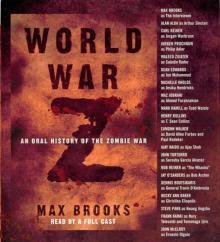 World War Z: An Oral History of the Zombie War
World War Z: An Oral History of the Zombie War Minecraft: The Island
Minecraft: The Island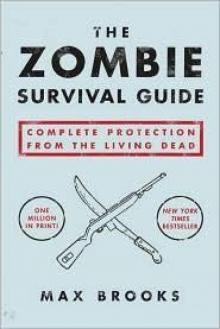 The Zombie Survival Guide: Complete Protection From the Living Dead
The Zombie Survival Guide: Complete Protection From the Living Dead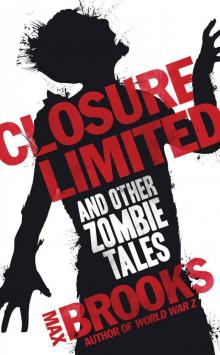 Closure, Limited and Other Zombie Stories
Closure, Limited and Other Zombie Stories Devolution: A Firsthand Account of the Rainier Sasquatch Massacre
Devolution: A Firsthand Account of the Rainier Sasquatch Massacre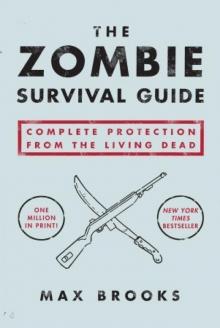 The Zombie Survival Guide
The Zombie Survival Guide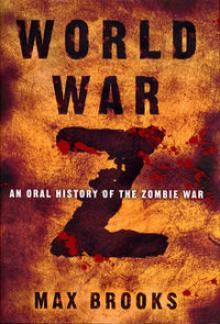 World War Z
World War Z Closure, Limited
Closure, Limited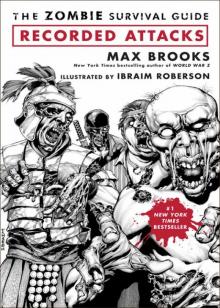 The Zombie Survival Guide: Recorded Attacks
The Zombie Survival Guide: Recorded Attacks World War Z_An Oral History of the Zombie War
World War Z_An Oral History of the Zombie War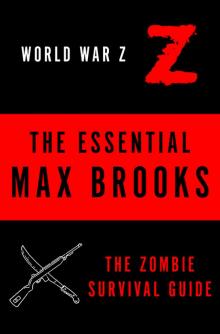 The Essential Max Brooks: The Zombie Survival Guide and World War Z
The Essential Max Brooks: The Zombie Survival Guide and World War Z